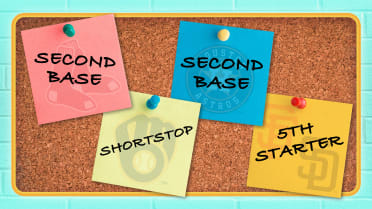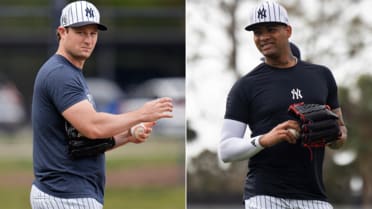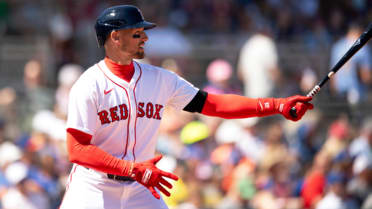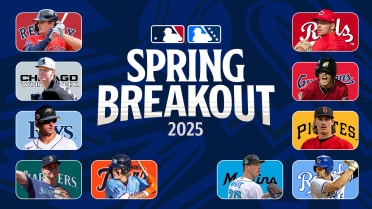Remembering the baseball greats we lost this past year
Today, on the final day of 2024, we take a look back at just some of the baseball people -- players, managers and executives -- we lost this year.
The deceased are listed in alphabetical order by last name, with their year of birth in parentheses. The baseball community is lessened by their absence, but their memories live on with all of us.
Peter Angelos (1929)
The principal owner of the Orioles for 31 years, Angelos was there on the night Cal Ripken Jr. broke Lou Gehrig’s record for consecutive games played. He died three days before the sale of the Orioles to the Rubenstein Group was finalized earlier this year. More >>
Billy Bean (1964)
Named MLB’s first Ambassador for Inclusion in 2014, Bean went on to make a huge impact while working on issues such as player education, LGBTQ inclusion and social justice initiatives. At the time of his passing in August, he was the league’s Senior Vice President of Diversity, Equity and Inclusion. In a previous chapter of his life, Bean had played six seasons in the Majors as an outfielder but retired at age 31, at a time when he felt the game wasn’t ready for an openly gay player. But in 1999, Bean came out publicly, and he wrote memorably about his career and life in his 2003 autobiography “Going the Other Way: Lessons from a Life In and Out of Major League Baseball.” More >>
Rico Carty (1939)
He had the first hit in Atlanta Braves history and batted .366 in 1970, a year when he was a write-in selection for the All-Star Game. Injuries riddled his career -- including a time he accidentally stabbed himself with a toothpick -- but he hit .299 over a 15-year run and is a member of the Braves Hall of Fame. More >>
Orlando Cepeda (1937)
The Baby Bull was an 11-time All-Star who won NL Rookie of the Year honors with the 1958 Giants, and both the NL MVP Award and a World Series ring with the 1967 Cardinals. He’s still a Giants legend, with his statue standing outside Oracle Park today. Cepeda remains revered in the San Francisco area for his humanitarian and community work. More >>
Rocky Colavito (1933)
A nine-time All-Star, Colavito remains both one of the best players in Cleveland history and among the best right-handed power hitters in baseball history. He also hit four homers in one game on June 10, 1959. There is no actual Curse of Rocky Colavito. More >>
Carl Erskine (1926)
A Brooklyn Dodgers legend, Erskine won a World Series in 1955 and threw two no-hitters in his career. He struck out 13 batters in Game 3 of the 1953 World Series. Erskine was the last surviving member of those “Boys of Summer” Dodgers, immortalized in Roger Kahn’s famous 1972 book. More >>
Jerry Grote (1942)
A member of the 1969 Miracle Mets, Grote was a two-time All-Star catcher renowned for his ability to work with pitchers. He played 16 seasons in the Majors and remains the Mets’ all-time leader in games caught. Johnny Bench once said, “If Grote and I were on the same team, I would be playing third base.” More >>
Don Gullett (1951)
A three-time World Series winner, he was a fantastic pitcher for the Reds and Yankees who would end up serving as the Reds’ pitching coach for more than a decade. He also gave up the 660th career homer to both Hank Aaron and Willie Mays. More >>
Bud Harrelson (1944)
A terrific fielder and a beloved Met, he played for the team for 13 seasons and also served as a manager and as a coach (including during the 1986 championship season). Harrelson was also on the 1969 championship team as a player. He was the first manager of the Long Island Ducks and, like Grote, played himself on an episode of “Everybody Loves Raymond.” More >>
Rickey Henderson (1958)
“If you could split him in two, you'd have two Hall of Famers,” wrote Bill James. There was no other player like Rickey, the all-time leader in runs scored, stolen bases and third-person self references. The greatest leadoff hitter of all time, a two-time World Series winner and a force well into his 40s, Henderson inspired a generation of ballplayers. More >>
Whitey Herzog (1931)
The White Rat started out as a scout and farm system director for the 1969 Mets. But his real work came as a manager, first with Kansas City, where he managed those Royals teams that kept losing to the Yankees in the AL Championship Series, and then with St. Louis, where his brand of “Whiteyball” led to three World Series appearances and one championship, in 1982. His Cardinals teams with Ozzie Smith, Willie McGee and Vince Coleman remain among baseball’s most beloved collections of speed, defense and excitement. More >>
Ken Holtzman (1945)
A member of those three-titles-in-a-row A’s of the ‘70s, he also threw two no-hitters in his career. As a young left-hander who was also Jewish, Holtzman was known as “the next Sandy Koufax” early in his career; he ended up having more career victories than Koufax. More >>
Ed Kranepool (1944)
Yet another Met from the 1969 team on this list, Kranepool spent his entire career with that franchise and still leads it in games played. He was a Mets legend in every way—yes, he was on that “Everybody Loves Raymond” episode, too—and was once so ubiquitous in New York that Bill Murray once interviewed him in a sketch on “Saturday Night Live.” More >>
Larry Lucchino (1945)
A longtime team executive, Lucchino served as president of the Orioles, Padres and Red Sox. As Red Sox president, he brought in Theo Epstein to work as general manager and ultimately celebrated that famous 2004 World Series title. When he died, Red Sox owner John Henry called him, “the greatest baseball man I ever met.” More >>
Willie Mays (1931)
One of baseball’s true giants, Say Hey Willie was the game’s preeminent five-tool player, a man who was better than everyone else at everything. A 24-time All-Star—the All-Star Game, it was said, existed primarily for Willie Mays -- he won 12 Gold Gloves, two MVPs and the 1954 World Series. MLB’s game between the Cardinals and Mays’ Giants this past June at Rickwood Field, where Mays once played for the Negro Leagues’ Birmingham Black Barons, became even more of a tribute to Mays, who died two days earlier. Mays was bestowed the Presidential Medal of Freedom in 2015. More >>
Pete Rose (1941)
Major League Baseball’s all-time Hit King built a legacy on the field but also irreparably marred it with a gambling scandal that ended with him permanently banned from baseball in 1989. More >>
Luis Tiant (1940)
El Tiante was one of the first great Cuban pitchers in the Majors, a strikeout maestro for Cleveland and, especially, the Red Sox. After joining Cleveland at the age of 20 in 1961, he was unable to return to Cuba and did not see his parents for 14 years; they watched him pitch in the 1975 World Series. His greatest year was 1968, when opponents batted only .168 against him. He appeared on an episode of “Cheers” and was the subject of the excellent ESPN documentary “The Last Son of Havana.” More >>
Fernando Valenzuela (1960)
The left-hander from Mexico is most famous for Fernandomania, which the then-20-year-old Dodger inspired in 1981 by winning his first eight starts (including five shutouts) en route to an NL Rookie of the Year Award, an NL Cy Young Award and a World Series title. Valenzuela went on to pitch 17 seasons in the Majors. He remains an icon in Mexico and served as President Obama’s special ambassador for citizenship and naturalization. More >>
Ozzie Virgil (1932)
In 1956, he became the first person from the Dominican Republic to play Major League Baseball and ultimately would play nine seasons, at every position other than pitcher and center field. He later was a coach for 19 seasons, including as the third-base coach for the NL pennant-winning Padres in 1984. More >>
Jimy Williams (1943)
Williams got in one game for the eventual World Series-winning 1967 Cardinals, but Williams made his career as a manager, leading the Blue Jays, Red Sox and Astros. He also was a two-time World Series-winning coach and was the Braves' third-base coach who waved home Sid Bream in Game 7 of the 1991 NLCS. More >>




